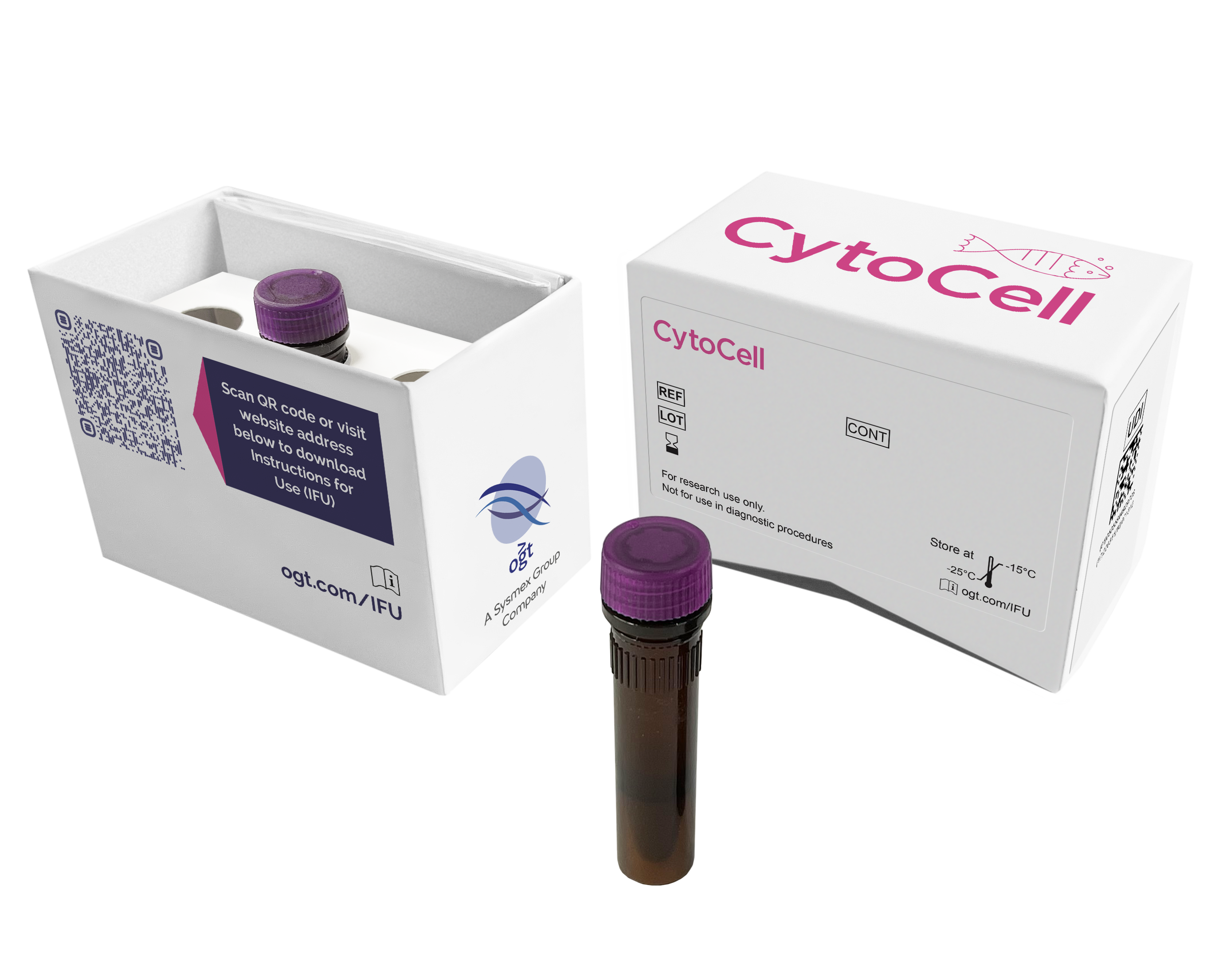
The TLX1 product consists of a 179kb probe, labelled in red, located centromeric to the TLX1 gene, including the KAZALD1 gene and the D10S1629 marker and a green probe covering a 124kb region located telomeric to the gene, including the LBX1 gene and the RH92279 marker.
The TLX1 (T-cell leukemia homeobox 1) gene at 10q24 is aberrantly expressed in 30% of adult and 5-10% of childhood T-cell acute lymphoblastic leukaemia (T-ALL)1,2.
Dysregulation of gene transcription is a feature of all acute leukaemias. In T-cell neoplasms, this is brought about by altered expression of normal transcription factor proteins, often as a consequence of chromosomal rearrangements placing these genes into close proximity of the promoter and enhancer elements of the TCR genes: TRA and TRD at 14q11.2, TRB at 7q34 and TRG at 7p143,4.
Murine studies show that expression of mouse homologues of TLX1 can immortalise haematopoietic cells in vitro as the first of a potential two-hit mechanism leading to full malignancy2. This work suggests that TLX1 is an oncogene that can become dysregulated via the translocations t(10;14)(q24;q11) or t(7;10)(q35;q24), placing it into close proximity with TRA/D and TRB elements respectively5. Additionally, TLX1 is frequently activated in T-ALL in the absence of an overt genetic rearrangement. T-ALLs with TLX1 expression show a more favourable outcome than other T-ALLs5.
Find certificate of analysis documentation for our CytoCell FISH probes

Our lab has been using a wide range of CytoCell FISH probes for a number of years, and have been increasing this range all the time. The probes have clear bright signals and show good reproducibility. CytoCell provides fast delivery of catalogue probes, and are very responsive when we have any queries or problems with their products.

Bridget Manasse
Addenbrookes Hospital, Cambridge University Hosiptals NHS Foundation Trust, UK
In our hands, CytoCell FISH probes have proven to be of the highest quality with bright, easy to interpret signals, thus providing confidence in our results. OGT's customer support is outstanding, as their staff are extremely knowledgeable and truly care about their customers and their customers’ needs.

Jennie Thurston
Director of Cytogenetics, Carolinas Pathology Group, USA
I first came across CytoCell FISH probes in a previous lab I worked in and I was struck by the quality of the products. Since this time, I have been recommending and introducing CytoCell probes across all application areas — now they are the primary FISH probes used in our lab. They have an excellent range of products and their ready-to-use reagent format saves considerable time.

Elizabeth Benner
Medical Technologist, University of Arizona Health Network, USA
We have been working with CytoCell fish probes for two decades because of their excellent clarity and intensity regardless of the size of the probe. It is so clear and simple to detect.
Dr. Marina Djurisic
Head of Laboratory of Medical Genetics, Mother and Child Health Care Institute of Serbia “Dr Vukan Cupic”, Serbia
The quality and consistency of CytoCell’s probes means I can trust the results, and my clients get their results in a timely manner.

Dr. Theresa C. Brown
Director, Cytogenetics Laboratory, Hayward Genetics Center, Tulane University School of Medicine, USA
It was very important for us to have more consistent results with our probes — easy-to-read bright signals and a range of vial sizes, which is much more cost-effective.

Janet Cowan, PhD
Director of the Cytogenetics Laboratory, Tufts Medical Center, USA
Not only do CytoCell offer an extensive range of high-quality FISH probes, the customer support is also excellent — providing fast access to all the probes I need. The probes are highly consistent with bright signals allowing easy scoring of results.
Dr. Eric Crawford
Senior Director, Genetics Associates Inc., USA
The quality and reproducibility of results using the CytoCell kit has been vital in accurately detecting co-deletions in our glioma investigations. We now have a cost-effective test that we can rely on that is also easy to use and interpret. We've been consistently impressed with this kit - not to mention the support offered by OGT's customer service, and have completely transitioned over to CytoCell probes.
Gavin Cuthbert, FRCPath
Head of Cancer Cytogenetics, Northern Genetics Servce, Newcastle, UK